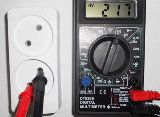Mains voltage
 An electric field has energy, which during operation creates an electric voltage acting on the charges in the wire. Numerically, the voltage is equal to the ratio of the work the electric field does in moving a charged particle along the wire to the amount of charge on the particle.
An electric field has energy, which during operation creates an electric voltage acting on the charges in the wire. Numerically, the voltage is equal to the ratio of the work the electric field does in moving a charged particle along the wire to the amount of charge on the particle.
This value is measured in volts. 1 V is the work of 1 joule that is done by the electric field moving a charge of 1 coulomb along the wire. The unit of measurement is named after the Italian scientist A. Volta, who designed a galvanic cell, the first source of current.
The voltage value is identical potential difference… For example, if the potential of one point is 35 V and the next point is 25 V, then the potential difference, like the voltage, will be 10 V.
Since the volt is a very commonly used unit of measurement, prefixes are often used for measurements to form decimal multiples of units. For example, 1 kilovolt (1 kV = 1000 V), 1 megavolt (1 MV = 1000 kV), 1 millivolt (1 mV = 1/1000 V), etc.
The network voltage must correspond to the value for which electricity consumers… When power is transmitted through connecting wires, some of the potential difference is lost to overcome the resistance of the supply wires. Therefore, at the end of the transmission line, this energy characteristic becomes slightly smaller than at the beginning.
The voltage drops in the network. This reduction, one of the main parameters, will certainly affect the operation of the equipment, be it lighting or electrical load. When designing and calculating power lines, it should be taken into account that the deviations in the readings of the devices measuring the potential difference must meet the established standards. Circuits calculated from the load current taking into account heating wires, control by value voltage drop.
The voltage drop ΔU is the potential difference at the beginning of the line and at its end.
The loss of potential difference in relation to the effective value is determined by the formula: ΔU = (P r + Qx) L / Unom,
where Q — reactive power, P — active power, r — line resistance, x — reactance, Unom — rated voltage.
The active and reactive resistance of the wires are selected according to the reference tables.
According to the requirements of GOST and the rules of electrical installations, the voltage in the electrical network can deviate from normal readings by no more than 5%. For lighting networks of domestic and industrial premises from + 5% to - 2.5%. The permissible voltage loss is no more than 5%.
In three-phase power lines, the voltage of which is 6-10 kV, the load is distributed more evenly and in them the loss of potential difference is smaller. Due to the uneven load in low-voltage lighting networks, a 4-wire three-phase current system with a voltage of 380/220 V (TN-C system) and five-wire (TN-S) is used... By connecting the electric motors to the linear wires and lighting equipment in such a system between the line and neutral conductors equalize the load of three phases.
What is the optimal network voltage? Consider the base voltage from a range of voltages standardized by the insulation level of the electrical equipment.
The nominal voltage in the network is the value of such a potential difference for which the sources and receivers of electricity are produced under normal operating conditions. Installed Rated voltage on the network and in connected users using GOST. The operating voltage in devices that create electricity, due to the conditions for compensating the loss of the potential difference in the circuit, is permissible 5% higher than the nominal voltage in the network.
The primary windings of the step-up transformers are power receivers. Therefore, their effective voltage values are the same as the magnitude of the nominal voltage of the generators. I have step-down transformers their average voltage is the same as the nominal mains voltage or 5% higher. With the help of the secondary windings of the transformers, closed to the supply circuit, the current is supplied to the network.To compensate for the loss of potential difference in them, their nominal voltages are set higher than in the circuits by 5-10%.
Each electrical circuit has its own nominal voltage parameters for electrical equipment that is powered by it. The equipment operates at a voltage other than nominal due to voltage drop. According to GOST, if the operating mode of the circuit is normal, the voltage supplied to the equipment should not be lower than the current by more than 5%.
The nominal voltage in the city network should be 220V, but it is not always true. This characteristic can be increased, decreased or unstable if one of the neighbors is engaged in welding or connecting a powerful tool. Abnormal voltage has a negative effect on the operation of household electrical equipment.
In case of overvoltage, electronic devices pose the greatest danger. They will fail sooner than the electric motor of a vacuum cleaner or washing machine. A hundredth of a second is enough, i.e. one high-voltage half-wave so that the switching power supply fails. Long-term exposure to increased potential difference is particularly dangerous, short-term waves are less dangerous.
For example, Lightning causes a spike in the voltage increase, but all electronics are reliably protected from such problems. The protection is powerless when the voltage rises for a long time. Organizations supplying electricity to the market are responsible for the quality of the electricity sold.
